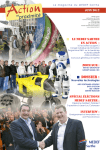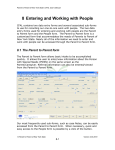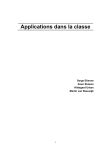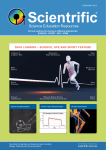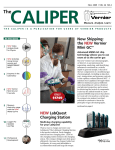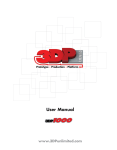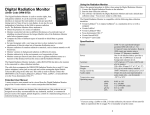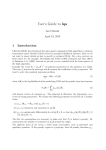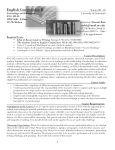Download Spring 2012
Transcript
CalIPEr ThE ThE CalIPEr IS a PublICaTIon for uSErS of VErnIEr ProduCTS MEASURE. ANALYZE. LEARN. SPrIng 2012 | Vol 29 no.1 introducing labQuest 2 ® in this issue 2 new Equipment to support advanced physics lab Book 3 polarizer/ analyzer Kit Experiments 5 identifying sugars in Everyday Beverages INVEST IGATIN G BiologyInquiry The Most Powerful, Connected, and Versatile Interface Ever through 6 new Investigating Biology through Inquiry lab Book AND GUIDED INQUIRY APPROACHES EXPERIMENTS USING OPEN since the announcement of labQuest abQuest 2 in early March, we have heard from teachers all over the world about the cool new features of labQuest abQuest 2 and the Connected science system. “ The LabQuest 2 is a completely different form factor and appears to have embraced many of the features, operations, and shape we are used to with our other handheld devices. 10 software Updates and new labQuest Viewer™ By Johnathan M. Melville Donald L. Volz Michael Collins MEASURE. ANALYZE. LEARN. It also appears that the fine folks at Vernier have not forgotten about the rest of our devices in that the LabQuest 2 can work with them as well through several connectivity options further changing the game. In fact, I’d go so far as to suggest that that very feature, called the Connected Science System, is an excellent example of a ‘disruptive technology’ and will surely become an industry standard option for all other similar devices in the future.” Martin Horejsi, NSTA blog 11 15 graphical analysis for ipad® professional Development Read the full blog post at www.vernier.com/r121 Joel Matykowski, a physics teacher at Century High school in Hillsboro, Oregon, beta-tested labQuest 2 with his students. Conducting a speed-of-sound experiment, the students were able to view and analyze data using ipads. according to Matykowski, “My students loved the way they could quickly collect and analyze data both in a group and on an individual basis using labQuest 2 and ipads.” More information about labQuest 2 can be found on pp. 8–9. www.vernier.com/labquest2 THE CalipEr | spring 2012 1 VErniEr sOfTwarE & TECHnOlOgy www.vernier.com pHysiCs new Equipment to Support Advanced Physics with Vernier – Beyond Mechanics lab book includes selectable entrance apertures, so that the sensor can sample small portions of the diffraction pattern for enhanced spatial resolution. The position sensor is based on a linear optical encoder. with zero backlash, the system can measure the light sensor position to better than 50 µm resolution. The new Advanced Physics with Vernier – Beyond Mechanics book is a follow-up volume to the first Advanced Physics with Vernier – Mechanics book, which focused mainly on mechanics and dynamics. an optional green laser is also available (gDl-DaK), which can be used to study the effect of wavelength on patterns. Both books share a philosophy based on interactive engagement with the instructor and other students. The activities are written under the plan that the instructor will engage students in discussion at critical junctures in planning, data collection, or analysis. in addition, the activities assume that students have learned how to perform common tasks such as linearizing a graph, and do not need detailed instruction in how to do so. To give you a sense of what this system can do, we looked at two different double-slit patterns, both taken with a red laser. The slit width is the same in these two runs, so that the overall envelope of the intensity pattern is unchanged. what’s different is the slit separation. in the lower graph, the slit separation is half that of the upper graph, so that the fine pattern has half the spatial frequency. in both cases, the vertical scale is set so that the smaller features in the pattern can be examined. some experiments in the books required that we introduce new equipment. an experiment about resistivity of materials makes use of our resistivity rod set (rrs), consisting of a variety of metal rods of various metals and cross sections. Basic optics begins with mirrors, so we now have a kit of concave and convex mirrors in our Mirror set (M-OEK). The most ambitious piece is our new Diffraction apparatus (DaK). Consisting of a red laser, a collection of high-precision, metal-on-glass slits, and a novel new combination linear position and high-sensitivity light sensor, the apparatus lets your students measure not only diffraction and interference fringe spacing, but also model the quantitative intensity variation of the patterns. The Diffraction apparatus parts snap to the same track as used in the Optics Expansion Kit and as found in the Vernier Dynamics system. a variety of slits allow students to see how patterns depend on slit width, number, and spacing. since the intensity of a diffraction pattern is much lower than other light sources, there is a new high-sensitivity light sensor. in addition, the light sensor normally a fussy experiment to set up, this apparatus lets your students do classic light-as-a-wave experiments quickly and easily. resistivity rod Set, rrs, $45 Mirror Set, M-oEK, $59 diffraction apparatus, DaK, $549 green diffraction laser, gDl-DaK, $250 Advanced Physics with Vernier – Beyond Mechanics lab book, pHys-aBM, $48 how do You fill Your Class Time? By John gastineau, ph.D. My new year’s holiday thoughts were quickly brought back to work and teaching, as on the radio i began to hear familiar names and voices talking about how physics is taught. Joe redish, David Hestenes, and others spoke about how lectures are often not as effective as we think—even if they are really good lectures. a report on npr’s All Things Considered gave a good summary of how the interactive teaching methods refined over the last two decades of physics Education research have spread to more institutions and into other disciplines. www.vernier.com/r122 The report was based on a longer American Radioworks series “Don’t lecture Me.” Check it out if you want to give your classroom game a fresh look. www.vernier.com/r123 Even engineering classes are losing the lecture structure, as reported in the Washington Post recently. www.vernier.com/r124 what i found interesting about these reports as a whole was that they are treated as national news. The education culture seems to be changing, so that students (and parents) may soon be surprised if class time is taken with traditional lectures. 2 THE CalipEr | spring 2012 VErniEr sOfTwarE & TECHnOlOgy www.vernier.com pHysiCs Polarizer/analyzer Kit Experiments we thought we’d share some experiments you can do with the new Vernier polarizer/analyzer Kit (paK-OEK). This kit, which includes three polarizer/analyzer units, expands the Optics Expansion Kit (OEK) so your students can study linearly polarized light. The three polarizer/analyzer units are the same in polarizing function, but traditionally, the first one struck by the light is called the polarizer, since it polarizes the beam. subsequent polarizing filters are then called analyzers, since they can be used to measure the polarization of the beam. a polarizing sheet works only by absorbing light of one polarization and passing another. it is a filter, albeit a clever one. with the addition of a third absorbing filter, the light transmitted by the system increases. How can that be? we leave that as an exercise for your students. Bonus points: predict the functional shape of the transmitted light vs. angle graph for the middle polarizer. Polarizer/analyzer Kit, paK-OEK, $68 Simple Machines using the Vernier dynamics System submitted by: Tim Barricklow, franklin County High school, in we set up an experiment to measure how light intensity varies with angle. with the OEK light source set with the lED fully exposed, the polarizer was set to pass vertically polarized light. a Vernier rotary Motion sensor (rMV-BTD) was attached to the analyzer to measure orientation. Using logger Pro, we plotted transmitted light intensity vs. the analyzer angle. The graph showed peaks every 0 and 180 degrees. Malus’s law tells us that the function should be that of a cosine squared function. That function (now one of logger Pro’s curve fits) fits the data well. students in Tim Barricklow’s class at franklin County Hs, indiana, learn important characteristics of simple machines through hands-on investigations. Using a Vernier Dynamics system (VDs) track, carts, strings, pulleys, and a Dual-range force sensor (Dfs-BTa), students investigate inclined planes and pulleys. To begin, students assemble the cart and track as an inclined plane. with the addition of a Dual-range force sensor and a pulley, students can pull the cart up the ramp with a constant force. students then analyze this force in logger Pro using the statistics function. after repeating these measurements at various ramp angles, students calculate the mechanical advantage and efficiency of each configuration. To investigate pulleys, students use the Dual-range force sensor to lift a mass via a pulley system attached vertically to a ring stand. students calculate the average force used to lift a mass with pulley systems of varying numbers of pulleys. again, students calculate the mechanical advantage and efficiency of each configuration. Challenge: finding the average force is a great way to simplify the concept of mechanical work. However, if the force is not constant, it can be difficult to examine this experimentally. Using the Vernier Dynamics system track and cart with a Motion Detector and Dual-range force sensor, it is possible to sample the quantities of force and displacement continuously. students can then analyze the data in logger Pro by numerically integrating the force data over the displacement to calculate the work. “Watts up” with Wired? Wired magazine’s science blog Dot physics recently used the watts Up pro (wU-prO) energy meter to measure two favorite physics topics: coffee and electric motors. The polarizer/analyzer Kit includes a third polarizing filter to study more complex phenomena. Our favorite is this little conundrum: set the polarizer and analyzer to a 90 degree difference in angle so that the light transmitted through the stack of two filters is at a minimum. now, insert the third polarizing sheet between the polarizer and the analyzer, set to about 45 degrees from the analyzer. in “Coffee pot physics,” author rhett allain looks at the power, energy, and temperature involved in brewing everyone’s favorite caffeine-laden beverage. www.vernier.com/r1225 in “power and Electric Motors,” allain starts by measuring the energy used by his home fridge and dives into a great explanation of why electric motors use more energy when they first start. www.vernier.com/r1226 THE CalipEr | spring 2012 3 VErniEr sOfTwarE & TECHnOlOgy www.vernier.com pHysiCs & EnginEEring how Much Energy does a dehumidifier use? Many homeowners in damp climates such as Oregon keep mold at bay with an electronic dehumidifier. These tend to be large, loud devices. we wondered just how much energy a dehumidifier uses? To find out, a watts Up pro (wU-prO) was used with a labQuest interface to collect real-time power consumption data. a relative Humidity sensor was also connected to labQuest to monitor the relative humidity, which is the amount of water vapor in the air compared to the maximum amount it can hold. SpectroVis® Plus with labVIEW a new addition to our labViEw offerings is sample code for our spectroVis plus (sVis-pl, $459) spectrophotometer. The spectroVis plus is an affordable CCD array spectrophotometer/fluorometer. CCD array spectrophotometer technology allows you to collect a full wavelength spectrum (absorbance, percent transmittance, or intensity). you can program the spectrophotometer to detect the peak wavelength. Once this is determined, you can create a program to determine the concentration of a solution (Beer’s law) or monitor the rate of a reaction. with its two different excitation wavelengths, you can also program the spectroVis plus to measure the fluorescence spectra of many compounds, such as chlorophyll, fluorescein, gfp, and more. we provide labViEw sample code for many of our devices. in addition, we frequently post software Development Kits (sDKs) for programmers to collect sample data with their own custom programs. we hope that providing these resources may lead to exciting student projects, sensor control programs, custom analysis, or sTEM classroom use that integrates more depth into the data-acquisition process. To see a list of all devices currently supported by labViEw go to www.vernier.com/r128 Time series for humidity (left axis) and power consumed by a dehumidifier (right axis) The power data show that when the compressor is on, it draws a whopping 470 watts. The fan also runs for several minutes after the compressor shuts down, which is the middle level of energy use near 200 watts. note that even when the dehumidifier is nominally off, it still draws about 3 watts. Because of the noise, the dehumidifier was turned off at night, yielding the long, low-energy spots in the graph. it is also interesting to note that the relative humidity quickly climbs during these periods. bite force: Komodo dragon vs. house Cat is the bite from a cat really stronger than the bite from a Komodo dragon? The Komodo dragon (Varanus komodoensis) is a very large monitor lizard that can grow up to 10 feet long and can weigh more than 150 pounds. it is a voracious predator that can ©istockphoto.com/ayimages take down prey as large as a deer or buffalo. yet a group of researchers, including stephen wroe from the University of south wales, found that the world’s largest living lizard has developed a unique system to take down prey that does not rely on bite force. The researchers used logger Pro to measure the output voltage of a strain gauge system designed to measure bite forces, and found that a cat does appear to have a stronger bite than the Komodo dragon. for more information about this interesting research, go to www.vernier.com/r127 4 THE CalipEr | spring 2012 for more information on the spectroVis plus go to www.vernier.com/r129 STEM activity: build a Sensor a great sTEM activity for your students is to have them build their own sensor or measurement device. One example is to build a strain gage to measure the tension and compression forces in a cantilever beam. in this activity, two strain gages are glued to a long metal bar, such that one is mounted on the top of the bar and the other is mounted on the bottom. when a force is applied to the end of the beam, it bends downward in proportion to the force (Hooke’s law). The top of the bar stretches as it is placed in tension, while the bottom of the bar compresses. The top strain gage is also stretched, and its resistance increases slightly because the length of gage wire increases while the width of the wire decreases. These effects are reversed for the bottom strain gage, causing its resistance to decrease slightly. These changes in resistance are small, but they can be measured accurately with the proper circuit and a Vernier instrumentation amplifier (ina-BTa, $59). a well-known circuit designed to convert small changes in resistance to changes in voltage is a wheatstone bridge circuit. when performing an activity such as this, students gain insight into design, construction, troubleshooting, and evaluation. They learn to measure the output voltage and use logger Pro calculated columns to mathematically convert raw voltage to proper units. They also learn an important lesson in what steps are required to successfully complete a project and work within a team. we have developed several activities designed to help you incorporate sTEM into your curriculum. To see a copy of this sensor activity, as well as others, go to www.vernier.com/r1210 VErniEr sOfTwarE & TECHnOlOgy www.vernier.com CHEMisTry an alternative to the Standard acid-base Titration Just when you think that every possible variation of acid-base titrations has been explored and documented, along comes one more—and this one is really interesting. larry Dukerich (arizona state University) and guy ashkenazi (The israel Center for Excellence through Education) constructed a custom logger Pro 3 experiment file so that an acid-base titration would plot the hydronium H3O+ ion concentration vs. the volume of OH– ions added to the reaction mixture. according to their article, displaying the titration data in this form allows the student to “determine the concentration of an unknown base by focusing attention on the point at which the [H3O+] appears to reach zero.” as part of the data analysis, Dukerich suggests that the student zoom in on the area of the plot near the equivalence point to observe that the hydronium ion concentration indeed is never exactly 0.00 M. Examining the data in this way, Dukerich asserts, opens the students’ eyes to a clearer view of an acid-base titration. see the complete discussion, along with sample data, at www.vernier.com/r1211 Progress of hydronium ion concentration during an acid-base titration Innovative use for the new Chemical Polarimeter Identifying Sugars in Everyday beverages By Melissa Hill, ph.D. The Chemical polarimeter is our newest instrument for college and advanced high school chemistry. it detects changes in rotation of plane-polarized light in the presence of an optically active compound. The polarimeter uses a light sensor and a bidirectional optical encoder to detect the quantity of light passing through the sample at each angle as the analyzer is manually rotated. a graph is produced that shows a clear change in the light’s polarization with respect to angle. This allows the user to determine various characteristics, including the identity of the specific chemical compound being investigated. we have written several experiments for the polarimeter, some of which can be found in our new lab book Organic Chemistry with Vernier. Others are available as free downloads at www.vernier.com/chem-pol. The following activity is a fun way to help students understand stereochemistry using our new polarimeter. in this activity, students use the polarimeter to identify which sugars everyday beverages have in common. first, it is necessary to concentrate the beverages. They are initially too dilute to see any differences in sugar content. One way to concentrate the solution is to dry 50 ml of each beverage over 10 g of na2sO4 (or similar drying agent). if you want a quantitative comparison between beverages, you should use the same volume of solution and mass of drying agent. you should also dry each solution for the same amount of time. Once the solutions are concentrated, it is possible to see the difference between diet soda that contains aspartame (α = +15°) and regular soda that contains fructose (α = –92°). you will also be able to tell if there is a difference between “natural” sodas that may contain glucose (α = +53°) or sucrose (α = +66°) as the primary sugar and a generic soda that will contain fructose. for college students, this can be extended to beer and wine to explore the percentage of sugar in each beverage. Clear liquids work best for these experiments, however, colored liquids can also be used. for instructions on using the polarimeter, see the user manual located at www.vernier.com/chem-pol Chemical Polarimeter, CHEM-pOl, $499 Standard graph of pH during acid-base titration Comparison of sugar in different sodas using the Polarimeter THE CalipEr | spring 2012 5 VErniEr sOfTwarE & TECHnOlOgy www.vernier.com CHEMisTry & BiOlOgy nEW! Investigating Biology through Inquiry lab book we are happy to announce that our new inquiry-based biology book, Investigating Biology through Inquiry, is now available. This book contains 22 activities that will help you integrate inquiry into your existing biology curriculum, whether you teach high school, ap* Biology, iB** Biology, or biology at the college level. Each investigation includes a preliminary activity, teacher information, sample researchable questions, and lots of sample data. investigations are correlated to ap and iB standards and are designed to meet the recommendations of the aaas “Vision and Change in Biology Undergraduate Education.” investigations include: •InvestigatingBuffers •Diffusion •investigating Osmosis •Chemistry of Membranes •investigating protein: The Bradford assay •Testing Catalase activity (O2) •Testing Catalase activity (gas pressure) •introduction to Biofuels: Enzyme action •analysis of Enzymes Using Tyrosinase •Cellular respiration •sugar Metabolism with yeast •fermentation with yeast •photosynthesis by Chloroplasts •Transpiration of plants •plant pigments •Heart rate •investigating Dissolved Oxygen •investigating primary productivity •Modeling population Dynamics •water Monitoring •Evolution of Cellobiase in fungi •introduction to Molecular Evolution •Evolution of yeast: artificial selection Praise for “analysis of Enzymes using Tyrosinase” from Investigating Biology through Inquiry “ After a literature search, many [students] wanted to investigate the action of tyrosinase from other sources and compare it to the potatoes, so they did extractions from apples, pears, bananas and even sweet potatoes. It proved to be a great inquiry lab.” Barb Burkhardt, University of Indianapolis, Indianapolis, IN INVEST IGATIN G BiologyInquiry through AND GUIDED INQUIRY APPROACHES EXPERIMENTS USING OPEN By Johnathan M. Melville Donald L. Volz Michael Collins MEASURE. ANALYZE. LEARN. boiling as a Cooling Effect Jon asbornsen of the Hawken school (gates Mills, OH) shared his work on a novel twist to a time-honored demonstration of boiling points that uses labQuest, a gas pressure sensor, and a Temperature probe. in the demonstration, a small volume of water is placed in a bell jar. as the air in the jar is evacuated, the water boils. asbornsen measured the pressure and temperature inside the bell jar. The graphs of his data tell the story more convincingly than mere observation of the phenomenon. asbornsen’s article can be read at www.vernier.com/r1212 if you are new to inquiry-based instruction, the extensive teacher sections will help guide you. in addition, this book also includes a primer on basic statistical tests and experimental design. Investigating Biology through Inquiry, BiO-i, $48 Pressure and temperature as a two-stage pump evacuates a bell jar BiOlOgy JOB OpEning Tyrosinase activity from potatoes, bananas, and sweet potatoes ** ap and advanced placement program are registered trademarks of the College Entrance Examination Board, which was not involved in the production of and does not endorse this product. ** The iB Diploma program is an official program of the international Baccalaureate Organization (iBO) which authorizes schools to offer it. The material available here has been developed independently of the iBO and is not endorsed by it. 6 THE CalipEr | spring 2012 Vernier’s Biology Department is about to grow! if you want to be part of the future of biology at Vernier, consider applying for our Biology Educational Technology specialist position. we’re looking for someone who is currently teaching or has recently taught high school biology and/or ap Biology using Vernier probeware. if you want to move to the northwest and be part of one of the “100 Best Companies to work for in Oregon” (for 13 years in a row), consider applying today. we’d love to have you join our team. application deadline is april 30, 2012. Visit www.vernier.com/jobs for details. VErniEr sOfTwarE & TECHnOlOgy www.vernier.com BiOlOgy Investigate Your Sense of balance using a force Plate nEW! activities for Teaching Evolution with Vernier The sense of balance is complex since it combines sensory input from the eyes, inner ear, and stretch receptors located in the tendons and muscles. in the classroom, you can demonstrate that visual input is important for balance. Try balancing on one foot with your eyes open, and then try it again with your eyes closed. you will find that balancing on one foot with your eyes closed is much more difficult than doing this with your eyes open. now that evolution is one of the Big ideas in the new ap Biology curriculum, many teachers have been asking how our sensors can be used to teach concepts in evolution. with this in mind, our Biology staff scientist, John Melville, developed several innovative ways to investigate evolution using Vernier products. all of these investigations can be found in our new Investigating Biology through Inquiry lab book. John Melville, our Biology staff scientist, has developed a simple and innovative way to quantify this difference in balance using a force plate (fp-BTa, $215). Just have a student balance on the force plate using one foot with their eyes open. when the student is ready, collect data for ten seconds. as the student shifts back and forth to maintain his or her balance, the force on the force plate will increase and decrease. The same test is then repeated while the student has his or her eyes closed. One simple and exciting activity is the “Evolution of yeast: artificial selection investigation.” Darwin’s theory of natural selection was influenced by his observation that farmers select plants and animals that have specific traits for breeding. This process is referred to as artificial selection. for thousands of years, humans have selected plants and animals for different traits, such as hardiness, drought tolerance, and productivity. after multiple generations of selective breeding, a strain or breed is established. students analyze their results by determining how much the force profile shifts back and forth during each balance test. The simplest way to do this is to find the standard deviation of the force profile during each test. The standard deviation tells us how far away a measurement is from the mean or average. in this case, the standard deviation of the force is a measure of how hard or easy it is for the student to balance. you can quickly determine the standard deviation of the force for each run using the statistics tool in logger Pro. if you are using a labQuest, choose the statistics option from the analyze menu. The yeast Saccharomyces is an excellent example of artificial selection. Different strains of yeast are used to make beer, bread, and wine. as a result, brewers and bakers have used artificial selection to select specific strains of yeast for each purpose. students start by measuring the respiration rate of baker’s yeast using a CO2 gas sensor (CO2-BTa, $249) and then design their own experiment. One researchable question students can investigate is, “what is the effect of ethanol on different yeast strains?” as shown in the sample data below, beer and wine yeast have a higher ethanol tolerance than baker’s yeast. in the sample data below, the standard deviation of force when the student is balancing with his or her eyes open is ±4.905 n. when the student’s eyes are closed, the standard deviation of force during the balance test is ±22.45 n. for questions about this and other biology investigations, contact [email protected] This is a great activity that lends itself to inquiry. students can easily compare the balance of males and females, athletes and non-athletes, or dancers and non-dancers, among others. for questions about this or other physiology activities, contact us at [email protected] Ethanol tolerance of lager, wine, and baker’s yeast a spECial OffEr from bio-rad laboratories to Vernier Customers: receive 10% off on all Bio-rad kits aligned with Investigating Biology through Inquiry or Advanced Biology with Vernier. for more information, go to www.vernier.com/r1213 Comparison of balance data with eyes open and closed THE CalipEr | spring 2012 7 VErniEr sOfTwarE & TECHnOlOgy www.vernier.com 2 Vernier labQuest 2 is a standalone interface used to collect sensor data with its built-in graphing and analysis application. The large, high-resolution touch screen makes it easy and intuitive to collect, analyze, and share data from experiments. its wireless connectivity encourages collaboration and personalized learning. you can also use labQuest 2 as a computer interface using logger Pro software for advanced analysis and video features. full sensor support faster analysis Compatible with all Vernier sensors Quick response to touch, curve fits, and modeling high-resolution touch screen • 12.8 cm, 800 x 480 pixel resolution • Designed for both stylus and touch • wide viewing angle for lab groups built-in sensors • • • • • gps 3-axis accelerometer ambient temperature light Microphone fast data collection 100,000 samples per second rechargeable batteries Wireless Connectivity High capacity, lithium-ion rechargeable battery 8 Key features new for labQuest 2 •Standaloneandcomputer interface with a touch screen •CompatiblewithallVernier sensors •Fastdatacollection •Rechargeable,high-capacity battery •CompatiblewithWindowsand Macintosh computers •Freesoftwareupdates •Collect,analyze,andshare sensor data wirelessly on any device with a compatible web browser •Largerandhigherresolution screen with portrait and landscape orientations •Additionalbuilt-insensorssuch as gps and accelerometers •Fasterprocessorforfastanalysis and graphing THE CalipEr | spring 2012 www.vernier.com/r1214 Take the labQuest 2 product tour and watch a video demonstration. VErniEr sOfTwarE & TECHnOlOgy www.vernier.com laBQUEsT 2 sOfTwarE Multiple runs can easily be stored and recalled later. Quick access to graphs, tables, and meters Live display of sensor data Curve fits and other analysis tools available One or two highresolution plots of data are displayed in real time. Curve fit statistics are displayed. built-In Software analYSIS fEaTurES •Performlinearand curve fits •Landscapeand portrait views •Supportsbuiltin sensors—gps, microphone, relative light sensors, accelerometers •Drawaprediction before collecting data •Displaytwographs at once •Displayatangent line on the graph •Integralfunction •Statistics oThEr grEaT fEaTurES •Stopwatch •Periodictable •Scientificcalculator •Audiofunction generator •Poweramplifier (requires Vernier power amplifier) •Exportdatato logger Pro •Morethan100 preloaded lab instructions from Vernier’s popular lab books •Notesfield •Voiceannotation with internal microphone •Findslopes,fitaline to a portion of your data, and display position data and its derivatives Meter one-Touch Simplicity The labQuest graphing and analysis application gives your students real-time graphing capabilities in a handheld device. it’s powerful—yet beautifully simple. buIlT-In aPPlICaTIonS Data Table Graph your students can collect data and view them in a data Table, Meter, or graph View. THE CalipEr | spring 2012 9 VErniEr sOfTwarE & TECHnOlOgy www.vernier.com sOfTwarE Introducing labQuest Viewer™ •CopyanimageoftheLabQuestscreenforuseinlabinstructions and assessment documents. •MonitorstudentprogressbyviewinganyLabQuestunit connected to your network. •Launchmorethanoneinstanceoftheviewertomonitor multiple labQuest units. Part of the Connected Science System™ labQuest Viewer is covered by our generous site license policy: purchase one copy of labQuest Viewer software, and install it on any computer in your school or college department. additionally, future upgrades of the software are free. The labQuest Viewer software is compatible with Macintosh® Os X® 10.5 (intel-based Macs only), 10.6, and 10.7 and windows® Xp (32-bit only), Vista®, and windows 7. for more information, visit www.vernier.com/r1215 labQuest Viewer (lQ-ViEw, $49) is our new Mac and pC computer software that allows you to display and control a labQuest right from your computer. (labQuest units sold separately.) when your computer is connected to a projector or interactive whiteboard, you can use labQuest Viewer to show a labQuest screen to the entire class. This is a great way to teach students how to use a labQuest or to allow students to present their data to the class. labQuest Viewer also allows easy capture of screen images, making it easy to create step-by-step lab instructions and assessment questions. labQuest Viewer software communicates with labQuest through a wireless connection. This means that you can view any labQuest connected to the network right on your teacher computer. Use this feature to monitor student progress and share student results in real time. wireless connectivity is built into labQuest 2 and can be added to an original labQuest using a wi-fi UsB adapter (sold separately, wifi-UsB, $59). labQuest 2 also supports a connection via UsB for use when wireless connectivity is not an option. note: The UsB option is not available when using the original labQuest. if this option is required, you will need to use the labQuest Emulator software. Key features •ViewandcontrolLabQuestfromacomputerorinteractive whiteboard. •CollectdatawithanysensorthatissupportedbyLabQuest. labQuest Viewer labQuest Emulator supported computer platforms Mac and pC pC only labQuest support labQuest 2 Original labQuest* Original labQuest only Communication wireless UsB (labQuest 2 only) UsB Use with computer and interactive whiteboards yes yes View multiple labQuests at the same time yes no supports UsB sensors (e.g., spectrometers) yes no supports all built-in sensors yes no Cost (includes site license and free upgrades when available) $49 free * requires wi-fi UsB adapter, sold separately 10 THE CalipEr | spring 2012 Software updates Have you updated your Vernier applications recently? we regularly release updates to support new devices and to add new features. Keeping up to date with software releases is one way to keep things running smoothly in your classroom or lab. loggEr Pro 3.8.5 – logger Pro 3.8.5 was released in april 2012. This update is free to all users of any previous version of logger Pro 3, and is available at www.vernier.com/r1216 Version 3.8.5 primarily adds support for labQuest 2, and it is required if you will be using the new interface. it also adds support for the Diffraction apparatus and projectile launcher. previous recent releases have added Data Marks and Data Tags, allowing you to attach notes to particular data points. Data Marks were developed to support the Melt station. new curve fits support the Chemical polarimeter, and Video analysis acquired several new features, including the ability to automatically skip frames and to calculate the center of mass for multiple objects. labQuEST 1.6 – labQuest 1.6 for the original labQuest was released in January, 2012. Version 1.6 adds support for the Chemical polarimeter, Diffraction apparatus, and projectile launcher. previous recent releases added Data Marks and Data Tags, as well as the Data Matrix. labQuest now supports the wDss with the addition of a Bluetooth® radio dongle. labQuest also supports labQuest Viewer with the addition of a wi-fi radio dongle. This free update is available at www.vernier.com/r1217 loggEr lITE 1.6 – logger lite 1.6 was released in March 2012 to support labQuest 2. The previous release of logger lite added support for labQuest Mini and windows 7 (including 64-bit machines), as well as linear fits. The free update is available at www.vernier.com/r1218 VIdEo PhYSICS for ioS – The current version of Video physics is 1.1.3, released in March, 2011. Updates to Video physics are always free and are available in the apple app store. VErniEr sOfTwarE & TECHnOlOgy www.vernier.com sOfTwarE Vernier Supports Mobile Technology Teachers using android™, ioS® and other mobile-platform devices now have solutions for data collection wHaT DOEs VErniEr HaVE fOr ipad ? ® graphical analysis™ for iPad graphical analysis allows every student in a lab group to connect to a shared labQuest 2 and get their own copy of the experimental data, live over a wireless connection. This makes it the perfect app for a one-to-one ipad program in a science classroom. instead of having an experiment tied to a single device, students can now collaborate with individual accountability. with graphical analysis, students perform curve fits and other data analysis functions made popular by logger Pro and labQuest. The advanced multi-touch interface makes these features easier to use than ever, in a simple, yet powerful, environment. The app also introduces new features, such as the ability to create multiple data selections with annotations and graph captions. students' projects are automatically saved for offline viewing, allowing them to take the data home and complete a lab report. graphical analysis also integrates with other ipad apps for education: send your data to numbers® or open your graphs in pages®, Evernote®, iBooks®, or many other notebook and writing apps. graphical analysis is the ultimate app for utilizing Vernier sensors to carry out hands-on experiments with the added student-centric power of ipad. for more information, go to www.vernier.com/r1219 Video Physics launched last year, Video physics quickly became one of the most popular tools for learning physics on ipad, ® Video Physics iphone, and ipod touch . This app is the easiest way for students to capture video of moving objects in the field. students can quickly track and analyze the motion of objects, and produce graphs of position and velocity in both the horizontal and vertical dimensions. what's more, Video physics allows users to quickly export the movie and data file to logger Pro for further analysis. for more information, go to www.vernier.com/r1220 arE yOU pUrCHasing iOs apps fOr sCHOOls? sHarE DaTa wiTH MUlTiplE DEViCEs Vernier Data share™ , the technology behind graphical analysis for ipad, also supports connection through a web browser. This means that you can perform data analysis with android-powered phones and tablets, Chromebooks, netbooks, laptops, and many other devices. More than just a viewer, Data share includes a full-featured web app with tools for data analysis and annotation. students get a live view of the data during collection, and the data is then stored as their own copy that they can access and analyze offline or take home. Data share web app provides many of the ground-breaking features found in graphical analysis for ipad. students can apply curve fits to multiple selections, as well as annotate data and add graph captions. Data share web app is the most flexible studentcentric data analysis tool ever, supporting many devices at once, many sensors at a time, and any device with a compatible web browser. it's perfect for hands-on science with a Bring-your-OwnDevice model or for any classroom with a mix of student devices. for more information, go to www.vernier.com/r1221 purchasing apps for iOs devices can be a challenge for schools. Did you know that your school or department can purchase vouchers to distribute apps such as Vernier Video physics to multiple devices? This is a way to distribute iOs apps to both school-owned and student devices. you can use purchase orders or credit card, and school purchases are tax-exempt. you receive a 50% discount when purchasing 20 or more copies of Vernier Video physics or Vernier graphical analysis. www.apple.com/itunes/education/ THE CalipEr | spring 2012 11 VErniEr sOfTwarE & TECHnOlOgy www.vernier.com awarDs Science Teachers Win Vernier/nSTa Technology award $3,000 in Technology and Cash awarded for Innovative uses of Vernier Technology Congratulations to the 2012 Vernier/nsTa Technology award winners! ElEMEnTary (graDEs K–5) Zoe ann Jorgensen, a.h. bush Elementary Magnet School, Idaho falls, Id when the idaho national laboratory needed a year of wind speed data to establish the viability of a small wind turbine installation, elementary teacher Jorgensen used the opportunity to have students conduct a real-world science investigation. Vernier technology was used to collect data that was presented to the school board and the idaho national laboratory. MiDDlE sCHOOl (graDEs 6–8) Shannon hudson, Tuttle Middle School, Crawfordsville, In Hudson used the vast history of her school’s soil to conduct interdisciplinary experiments. Her school sits on a hill that was once a tropical ocean, a deciduous forest, and crop fields. students used Vernier equipment to conduct various soil experiments over a period of months and compared data to explain their results. Christopher Widmaier, World of Inquiry School, rochester, nY widmaier’s students use probeware to complete an investigation of varying light levels in different environments. They will use this data to help understand the influence of ultraviolet light on living organisms and human skin color. HigH sCHOOl (graDEs 9–12) Sharla dowding, Ed.d, newcastle high School, newcastle, WY Encouraging her students to think inquisitively about what they eat, Dowding has her students use Vernier technology to conduct investigations such as finding the food coloring concentration in fruit loops, the concentration of color in Kool-aid solutions, and the amount of sugar in soda. John l. gensic, new Prairie high School, new Carlisle, In gensic’s students conducted experiments on well water feared to be contaminated by septic systems and over-fertilized farm land. Understanding well-water quality helps these students understand their surrounding’s resources. COllEgE Venkatesh gopal, Elmhurst College, Elmhurst, Il gopal’s project is to build an audio-frequency working model of a phased-array radar as a striking demonstration of time-reversal in optics and acoustics. The project will be used in an upper-level course on modern optics. The Vernier/nsTa Technology awards promote the innovative use of data-collection technology using a computer, graphing calculator, or other handheld in the science classroom. we encourage you to apply for one of seven $3,000 awards. To apply for 2013, see www.vernier.com/r1222 VErnIEr aWardS Vernier is proud to be recognized for its philanthropic commitment, steady growth, and as one of the Best 100 Companies to work for in Oregon—for 13 years in a row. INTERNATIONAL AWARD FOR LABQUEST FASTEST GROWING PRIVATE COMPANIES PLACED 25TH OF 100 BEST GREEN COMPANIES IN OREGON 2011 HEALTHIEST EMPLOYERS 6TH PLACE OREGON BUSINESS AWARD Jacqueline bondell, north Carolina School of Science and Mathematics, durham, nC Ershela Sims, north Carolina School of Science and Mathematics, durham, nC Bondell and sim’s physics and robotics classes teamed together and designed a walking robot. The successful program is being adapted into a teacher workshop as a model of an applied sTEM activity for other classes. logger Pro, labQuest, labpro, Vernier and caliper design, go!, logger lite, Vernier EasyTemp, Vernier Easylink, and Vernier EasyData are our registered trademarks in the United states. Vernier software & Technology, vernier.com, and graphical analysis are our trademarks or trade dress. all other marks not owned by us that appear herein are the property of their respective owners. iphone, ipad, and ipod touch are trademarks of apple inc., registered in the U.s. and other countries. 12 THE CalipEr | spring 2012 VErniEr sOfTwarE & TECHnOlOgy Vernier in the Science Journals Our products are often used in innovative experiments and demonstrations described in journals. Here are some recent ones from The Physics Teacher: “Vibration analysis and the accelerometer,” The Physics Teacher, november 2011 by paul Hammer, East Catholic Hs, Manchester, CT. This article shows how to use our accelerometers and logger Pro to obtain useful information about vibrating objects, such as small fans, motors, and pumps. The ffT feature of logger Pro makes this analysis relatively simple. “laboratory activity: specific Heat by Change in internal Energy of silly putty,” The Physics Teacher, December 2011, by John Koser, University of st. Thomas, st. paul, Mn. in this article, the author describes an experiment, designed for undergraduate liberal arts majors, to show the conversion of mechanical energy to heat energy. He uses our temperature sensor placed inside a blob of silly putty®. “Empowering Technology and pOETry supporting scientific inquiry: investigating the Motion of a rebounding Trolley,” by Hildegard Urban-woldron, University of Vienna (austria), shows how to use the Ti-nspire and one of our Motion Detectors to do a very complete analysis of the bounces of low-friction carts. The curve-fitting features of the Ti-nspire are nicely demonstrated. 25 years ago in ThE CalIPEr 25 Years ago in The Caliper: we discussed compatibility with the new apple ii gs computer and noted with great enthusiasm that The Physics Teacher magazine had devoted their entire May 1987 issue to “Computers in the Classroom.” Using computers in physics teaching was catching on! SCIEnCE huMor This time we have two scientific bar jokes: some mathematicians go into a bar. The first orders a beer. The second orders a half beer; the third a quarter of a beer. The bartender slams down two beers and says, “Know your limits.” “we don’t allow faster-than-light neutrinos in here,” says the bartender. a neutrino walks into a bar. www.vernier.com nEW! real-World Math with Vernier lab book Real-World Math with Vernier is a newly revised lab book containing E 32 activities that connect real-world CONNE CTING MATH AND SCIENC applications with concepts such as functions, statistics, systems of equations, and others from algebra through calculus. with the gaining popularity of the Ti-nspire technology in math, we adapted the activities from the previous Real-World Math books for use with the Ti-nspire using our DataQuest application for collecting sensor data. The Ti-nspire versions of our student activities make use of the many features unique to the Ti-nspire, including movable lines, sliders, and calculated columns. orld Math Real-W WITH VERNIE R By John Gastineau Chris Brueningsen Bill Bower Linda Antinone Elisa Kerner MEASURE. ANALYZE. LEARN. • Use the Vernier gas pressure sensor to show the linear relationship between depth and pressure or to investigate inverse relationships through pressure and volume. • Model a walker’s motion using a piece-wise continuous function, plot an ellipse with a swinging pendulum, or introduce your students to statistics through analyzing height data collected with a Vernier Motion Detector. • Explore logistic functions as students locate the equivalence point in a titration with the Vernier pH sensor. The Real-World Math with Vernier lab book includes teacher information pages with tips and sample data, complete student activities for the Ti-nspire in the printed manual, and a CD of modifiable student versions in Microsoft® word®. student instructions on the CD include Ti-nspire technology, EasyData, DataMate, and logger Pro versions. for standard and textbook correlations, experiment previews, and more, please visit www.vernier.com/r1223 real World Math with Vernier, rwV, $48 rick Sorensen is retiring rick joined Vernier software & Technology in 1994. we got to know him as a local physics teacher. rick has been a very valued friend and colleague ever since. He has led our company’s very important collaboration with Texas instruments, which included development of CBl, CBl 2, labpro, Ti-nspire lab Cradle, and many related products. He has been a key player on our physics technical support/r&D team, and he has been the driving force behind most of our physics products, including our new Centripetal force apparatus and projectile launcher. rick has been a senior partner at Vernier for over a dozen years. we will all miss him, and we wish him a happy retirement. THE CalipEr | spring 2012 13 VErniEr sOfTwarE & TECHnOlOgy www.vernier.com VErniEr arOUnD THE wOrlD Vernier Equipment used for Monitoring South american rain forests we recently received reports and photos of two great projects involving water quality monitoring in south america. Jack sanford and some of his students from Derryfield school, Manchester, nH, recently completed a trip to the rain forest of Ecuador. They were documenting the populations of amphibians and measuring some environmental parameters that affect them: pH, temperature, and conductivity. They used our sensors and labQuest for the field work. Canadian Workshops are you one of our Canadian customers? if so, let Merlan scientific customize a Vernier workshop for your school! we know that opportunities for teacher professional development are limited, and we can help you make the most efficient use of your valuable time. request a customized workshop quote today! 1-800-387-2474 | [email protected] | www.merlan.ca Investigate the Iron hypothesis in the late 1980s, Dr. John Martin made a prediction that iron was a factor limiting phytoplankton growth. He hypothesized that increasing the amount of available iron in the ocean would increase primary productivity, ultimately leading to a decrease in the amount of carbon dioxide in the atmosphere, an idea known as the iron hypothesis. seeding the ocean with iron has been suggested as one way of mitigating global climate change. The Biology Department at Vernier has developed a simple way to demonstrate the iron hypothesis. increasing concentrations of iron (ii) gluconate were added to samples of water containing algae (Chlorella). we used the protocol from our new Investigating Biology through Inquiry lab book (BiO-i, $48) to measure primary productivity of each sample. as the data show, productivity increased as the iron concentration increased. New Hampshire students measure water quality in Ecuador for more details on this investigation and the iron hypothesis, visit www.vernier.com/r125 Junior scientists @ iracambi is a program that teaches students about the environment in the atlantic forest of northern Brazil. They have about 100 local students involved once a month. The Junior scientists have done soil and water monitoring, recorded weather data, started on tree identification, and learned how to make tree seedlings. They use our water quality and soil moisture sensors. Thanks to Binka le Breton, project leader, for the photos and information on this program. you can watch a 3-minute video about the Junior scientists at www.vernier.com/r1224 Increasing amounts of iron in solution produce an increase in both net and gross primary productivity Brazilian students become Junior Scientists in the Atlantic Forest 14 THE CalipEr | spring 2012 Please pass this newsletter on or recycle it again. VErniEr sOfTwarE & TECHnOlOgy www.vernier.com prOfEssiOnal DEVElOpMEnT free hands-on, data-Collection Workshops hands-on Training using labQuest 2 and labQuest Mini Join us for a free, 4-hour, hands-on workshop using labQuest 2 and labQuest Mini to learn how to integrate our computer and handheld data-collection technology into your science curriculum. The workshops include lunch or dinner and lab handouts on CD. for more information and registration, contact us or visit our web site at www.vernier.com/r126 APRIL MAY 16 18 19 24 25 26 28 30 30 30 1 1 3 3 Memphis, Tn Jackson, Ms Baton rouge, la princeton, nJ newark, nJ white plains, ny Bridgeport, CT Hartford, CT san Jose, Ca Tri Cities, Tn Oakland, Ca winston-salem, nC sacramento, Ca Columbia, sC one day Summer Workshops Join us for a day using labQuest 2 and labQuest Mini to learn how to integrate our data-collection technology into your chemistry, biology, physics, middle school science, physical science, and Earth science curriculum. These 6-hour, hands-on workshops include lunch and lab handouts on CD. The cost of the workshop is $99. JUne 11 Dallas, TX 11 Omaha, nE 14 little rock, ar 14 Minneapolis, Mn 25 atlanta, ga 25 Chicago, il 28 raleigh, nC 28 Cleveland, OH Physics/aP Physics* high School Two-day Institutes biology/aP* biology baltimore, Md | July 9–10 These Biology/ap Biology summer institutes will feature hands-on training using labQuest 2 and labQuest Mini integrating technology into your biology class. a variety of experiments will be offered, including many that align with the new ap Biology curriculum framework. specific emphasis will be placed on how to conduct inquiry-based laboratory investigations. The $199 registration fee includes a copy of Investigating Biology through Inquiry. aP* Chemistry denver, Co | June 20–21 AUgUst 6 Beaverton, Or 9 spokane, wa high School/College Two-day Institutes denver, Co | June 18–19 denver, Co | June 22–23 JULY 16 Boston, Ma 16 phoenix, aZ 19 philadephia, pa 19 san Diego, Ca baltimore, Md | July 11–12 Vernier and flinn scientific will co-host these ap Chemistry hands-on technology institutes using labQuest 2 and labQuest Mini. During these summer institutes, teachers will do many of the experiments recommended by The College Board. These experiments will center around Vernier and flinn equipment, supplies, and kits. The $199 registration fee includes a copy of Advanced Chemistry with Vernier. online Webinars Vernier holds free, one-hour training events online. The presenter will give a tour of Vernier products and answer questions. all you need is a broadband internet connection and a phone line. recorded versions will also be available for download. baltimore, Md | July 13–14 This institute will survey physics data-collection and video tools offered by Vernier. participants will learn both basic and advanced skills in logger Pro. Video capture and analysis will be emphasized. Data collection will use labQuest 2, labQuest Mini, and a variety of physics sensors. The $199 registration fee includes a copy of Advanced Physics with Vernier – Mechanics. College Two-day Institutes College biology Chicago, Il | august 6–7 in this institute, you will conduct a series of laboratory exercises using labQuest 2 and labQuest Mini that are designed for general biology at the college level. areas of focus will include cellular respiration, carbohydrate metabolism, enzyme kinetics, photosynthesis, and more. Options for human physiology, ecology, and biotechnology will also be presented. The $199 registration fee includes a copy Advanced Biology with Vernier. College Chemistry Chicago, Il | august 8–9 Vernier and flinn scientific team up to present this institute. you will investigate many important topics in chemistry, including thermodynamics, kinetics, acid-base reactivity, and equilibrium. Data collection and analysis will open your eyes to new ideas for hands-on activities in your laboratory using labQuest 2 and labQuest Mini. The $199 registration fee includes a copy of Advanced Chemistry with Vernier. for more information and registration for these training opportunities, go to www.vernier.com/training/ * AP and Advanced Placement Program are registered trademarks of the College Entrance Examination Board, which was not involved in the production of and does not endorse this product. THE CalipEr | spring 2012 15 Toll free 888-837-6437 www.vernier.com prsrT sTD U.s. pOsTagE paiD salem, Or permit no. 526 13979 sw Millikan way Beaverton, Or 97005-2886 MEASURE. ANALYZE. LEARN. aDDrEss sErViCE rEQUEsTED Follow us on Twitter and become a Vernier fan on Facebook TM facebook is a registered trademark of facebook, inc. nEW Vernier Projectile launcher investigate important concepts in two-dimensional kinematics. www.vernier.com/vpl OrDEr CODE Vpl $289
















